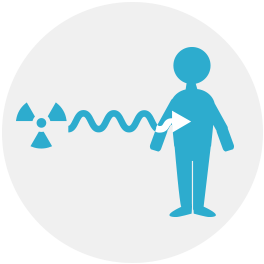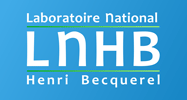Quality control for radiotherapy

Dosimetric techniques for quality control of radiotherapy treatments
All the equipment required for radiotherapy treatment is subject to quality control procedures, either separately or as a whole. Treatment planning software is an essential part of this process. In order to validate them, the LNHB is studying detection systems that allow point measurements in 2D, 3D and in a given volume.
Point detectors that can be used for in vivo dosimetry (e.g. TLD OSL) partially answer the question. Indeed, it is necessary to use a large number of detectors to make a volume mapping of the dose distribution in an anthropomorphic phantom representing a patient.
Films, e.g. Gafchromic, can be used to take a step towards a more global measurement by taking measurements in the planes that must then be assembled to reconstruct a 3D cartography. Independently, their use is also being considered to characterize the profiles of small fields.
3D dosimetry is the ultimate step that gives access to three-dimensional mapping in a single operation. The LNHB is working on the characterization of a new Fricke chemical dosimetric gel with Magnetic Resonance Imaging (MRI) reading in collaboration with the CRLCC Jean Perrin of Clermont-Ferrand and the Toulouse University. This gel offers interesting prospects for use in hospitals as an internal quality control method. However, improvements need to be made, in particular as related to the detection limit, spatial resolution and measurement uncertainties. The current study focuses on improving the dosimetric characteristics of gel. These depend on its chemical properties and the performance of the associated reading method.
This method, based on the reading of dosimeters by MRI, is also a good candidate for 3D dose distribution measurements on the new MRI-guided radiotherapy machines. The presence of a constant magnetic field does not interfere with the measurement, unlike other dosimeters, and the MRI reading of the gel can be done directly with the machine’s imaging device. These studies will be carried out as part of the European project EMPIR “Metrology for MR guided Radiotherapy (MRgRT)”, aiming to develop the metrological bases for the use of this radiotherapy technique (dose dosimetric traceability, dose calculation, imaging).
In addition to measuring techniques for determining the 3D distribution of doses in the patient, an alternative is to place a dosimeter, whose volume is that of a tumour, in an anthropomorphic phantom. It is then necessary to plan and carry out a treatment as it would be for a patient and then verify that the dose delivered to the tumour corresponds to the expected dose. LNHB has developed this technique using alanine detectors.
EMPIR COLLABORATIVE PROJECTS:
– MRgRT “Metrology for MR guided radiotherapy”
Website: https://www.euramet.org/research-innovation/search-research-projects/details/?eurametCtcp_project_show%255Bproject%255D=1404
REFERENCES:
– N. Périchon T. Garcia, P. Francois, V. Lourenço, C. Lesven, J.-M. Bordy, Calibration of helical tomotherapy machine using EPR/Alanine dosimetry, (2011), Medical Physics 38, 1168
DOI: 10.1118/1.3553407
– T. Garcia, T. Lacornerie, R. Popoff,, V. Lourenço, J.-M. Bordy, Dose verification and calibration of Cyberknife® using EPR/Alanine dosimetry, (2011), Radiation Measurements, volume 46 issue 9, pages 952-957;
http://dx.doi.org/10.1016/j.radmeas.2011.03.031
– J.-M. Bordy et al., Radiotherapy out-of-field dosimetry: Experimental and computational results for photons in a water tank, (2013), Radiation Measurements Volume 57,
DOI: 10.1016/j.radmeas.2013.06.010
PARTNERSHIPS:
– Centre Jean Perrin – Centre Régional de Lutte Contre le Cancer d’Auvergne
Website: http://www.cjp.fr/fr/
– Université Paul Sabatier de Toulouse
